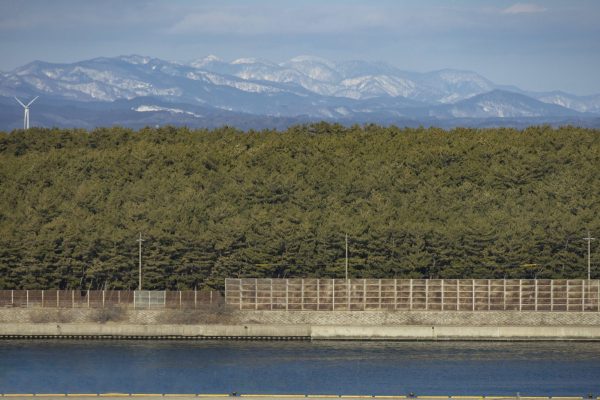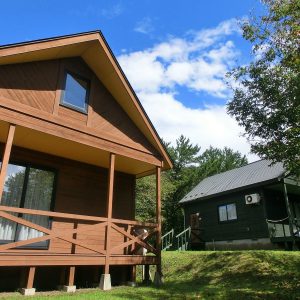Walk through one of Japan's largest black pine groves.
Kaze no Matsubara Forest
Categories: Nature/Lifestyle
One of the five great pine forests in Japan
“Kaze no Matsubara Forest” is located along the coast of Noshiro City in Akita Prefecture, and is one of the five great pine forests in Japan(※).
This pine forest stretches 14 kilometers in length and covers an area equivalent to approximately 163 Tokyo Domes (760 hectares). It has 7 million pine trees, and since it’s located close to the city center of Noshiro, it’s a great spot for locals to walk or bike, offering the perfect urban forest experience.
The forest ecosystem of “Kaze no Matsubara Forest” is rich and diverse, with wildlife such as wild raccoons, rabbits, foxes, and eagles. There are also several easy-to-follow trails in the forest, giving locals a chance to exercise or take a relaxing walk.
The area also houses the Omori Inari Shrine, dedicated to the gods of commerce and mountains, attracting many business and forestry professionals who come to pray for prosperity.
The unique landscape of Kaze no Matsubara Forest has earned it numerous accolades, including:
- ●One of the “100 Best Japanese Nature Spots of the 21st Century”
- ●One of the “100 Best Pines of the 21st Century”
- ●One of the “100 Best Forests for Forest Bathing in Japan”
- ●One of the “100 Best White Sand and Green Pine Landscapes of the 21st Century”
- ●One of the “100 Best Soundscapes in Japan”
- ●One of the “100 Best Fragrance Landscapes in Japan”
These honors have solidified Kaze no Matsubara Forest as a beloved and significant place in the hearts of Noshiro residents.
(※ The five great pine forests of Japan are: Miho no Matsubara in Shizuoka Prefecture, Kehi no Matsubara in Fukui Prefecture, Niji no Matsubara in Saga Prefecture, Amanohashidate in Kyoto Prefecture, and Kaze no Matsubara in Akita Prefecture.)

History of Kaze no Matsubara
Kaze no Matsubara was not naturally formed, but rather is an artificial forest created through the joint efforts of the government and local residents.
Before the Edo period(1603–1868 AD), due to the area’s terrain and climate, the strong sea winds would blow large amounts of sand onto the land every year, burying homes and farmland, and even blocking estuaries. These natural disasters forced residents to frequently relocate.
To prevent the sand dunes from invading, large-scale planting of black pines began in 1711. These trees were effective in withstanding the strong sea winds. As a result, the pine forest gradually took shape, eventually becoming the urban forest we see today.
Although the forest faced decline later on due to logging and the production of pine resin oil, Kaze no Matsubara was designated as a protected forest after 1940s. Since then, it has been effectively preserved and continues to thrive to this day.

Pine Wilt Disease and the Future of Kaze no Matsubara
Pine Wilt Disease is a devastating tree disease that has caused concern across many countries in Asia. It is caused by the pine wood nematode.
The pine wood nematode lives on the pine sawyer beetle. When the beetle feeds on the soft branches of pine trees, the nematodes enter the tree and cause it to die. Once a tree is infected, it can’t be saved. In the Tohoku region, pine trees with Pine Wilt Disease quickly turn red and wilt from summer to autumn.
In November 1999, Pine Wilt Disease first broke out in Kaze no Matsubara. While the number of infected trees was effectively controlled for a time, the spread of the disease worsened in 2023, partly due to unusually high summer temperatures and other climate factors.
It is estimated that approximately 17,000 cubic meters of pine trees have died across Kaze no Matsubara, marking the most severe outbreak in the last 15 years.
To combat this issue, authorities plan to use drones and other equipment to spray pesticides over about 390 hectares of pine forest along the coastline.
Local residents are also actively involved in volunteer efforts to protect this precious pine forest. At the annual “Kaze no Matsubara Volunteer Event,” residents of Noshiro City come together to remove dead branches from the trees. Since these dead branches are breeding grounds for the pine sawyer beetle, clearing them helps significantly reduce the risk of Pine Wilt Disease infection.
The local community understands that if the windbreak forest is not protected, the entire city could be buried by sand within the next 50 years. More importantly, over 300 years of history and culture could disappear. Therefore, the people of Noshiro are deeply committed to protecting these precious pine trees, determined to preserve their legacy and ensure a safe home for future generations.

Details
- Postal Code
- 016-0894
- Address
- 1-28 Haginodai, Noshiro, Akita



























